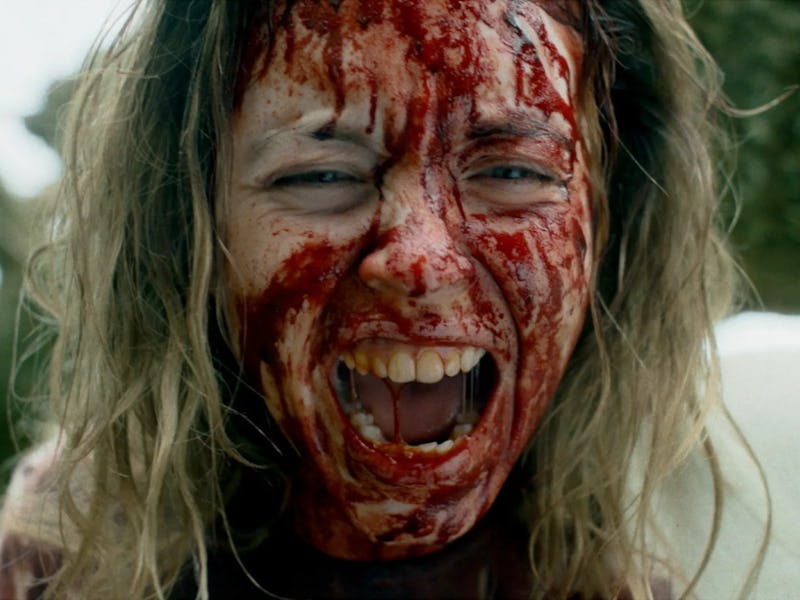Let’s Talk About The Shocking Ending of Immaculate
Sydney Sweeney and director Michael Mohan reveal the ending was originally going to look a lot different.

When first reactions for Immaculate came out of South by Southwest, the standout elements were clear: the shocking ending critics called “ballsy,” and Sydney Sweeney’s no-holds-barred performance, which took a mild-mannered nun from Michigan and slowly morphed her into a blood-soaked scream queen fighting to save her life — and end another.
Immaculate is the product of Sweeney — hot off the heels of co-producing Anyone But You — looking to do a horror movie. She had always wondered what happened to a script she auditioned for a decade ago that never panned out.
“It became more of putting the right puzzle pieces together.”
“I loved the horror elements of fear of reality and mankind, and the fear being something you can't escape,” Sweeney tells Inverse. “Cecilia as a character, for an actor, is such an interesting, crazy journey to go on. It's always fun having a character that starts from one extreme and goes to the complete other end of the spectrum.”
Together with Michael Mohan, who directed Sweeney in Everything Sucks! and The Voyeurs, Sweeney tracked down the script and Immaculate was born. “It was a bit tricky because the script was locked up for a while and I had to wait to be able to pull out the clean original draft. Once I was able to do that, then it became more of putting the right puzzle pieces together,” Sweeney says.
But all the same, the script needed work. The entire setting and ending were completely different than the one that had critics buzzing. Sweeney and Mohan revealed to Inverse what the original version of this movie looked like — and how different its message almost was.
Warning! Spoilers for Immaculate below.
Sweeney plays an American nun trapped in an Italian convent with a dark secret in Immaculate.
Immaculate ends with young nun Cecilia (Sweeney), impregnated against her will as the result of a biological experimentation, fighting her way out of the Italian convent that’s entrapped her — all while in active labor. When she finally makes her way out, she gives birth in one harrowing shot that doesn’t shy away from showing every painful scream. It’s the shining moment for Sweeney’s performance.
“I always feel so bad whenever we talk about this final scene because we set the camera and Mike was like, ‘Do you want to run through? Do you want to rehearse it?’ I was like, ‘No, let's just go for it and see what happens,’” Sweeney says. “We did it, and that was the first take that you saw.”
“Every actor has a superpower and Syd's number one superpower is being able to just immediately go to an incredibly vulnerable and visceral place,” Mohan tells Inverse. “My job as a director, sometimes, you have to get in there and really help and sometimes, the best note a director can give is no notes.”
That vulnerability is only heightened when Cecilia finally gives birth and, without hesitation, takes a rock and smashes in the skull of the baby. It’s a hard scene to watch, even if the camera never strays from Cecilia’s face. But it wasn’t what was in the script when it was first acquired.
“‘Oh, right, of course, yeah. Let’s smash that baby.’”
“It was a very conservative ending where she gives birth to the baby and then there’s a time cut to years later and she’s sitting on the playground watching her child play,” Mohan says. It was the first thing he brought to screenwriter Andrew Lobel as a possible change. “When I said we needed to murder the baby he was just like ‘Oh, right, of course, yeah. Let’s smash that baby.’”
It’s a moment of great catharsis for Cecilia and one that’s subtly foreshadowed throughout the entire movie. Mohan worked with prolific colorist Andrea Chlebak (Mandy, Watchmen) to add film grain that symbolizes her journey.
“We created an architecture to the grain where the stock at the beginning of the movie is a lot more clean,” Mohan says. “It gets grainier and grainier until we're taking the film grain from a scan from an exposed negative of 16 millimeter [film.] When it's even further when they're fighting, it's a dirty film grain and then, when she finally escapes, we go back to the beginning where it's nice and clean.”
Immaculate’s nun-centric story wasn’t in the original draft.
Throughout the entire promotion tour for this movie, Sweeney has avoided calling this movie “nunsploitation”: the subgenre of shocking, usually horrific movies that juxtapose the suppressive convent environment with a sexual or violent plot. But her avoidance isn’t because she doesn’t want Immaculate to be associated with the genre, it’s because the setting itself was an afterthought.
“I think one of the hallmarks of that genre that we sort of just did it unwillingly.”
“It never started in a nun environment. That's why the original script was set in a boarding school in Ireland, and she was 15, 16 years old,” Sweeney says. By the time the film made it to production, Sweeney was 10 years older and couldn’t feasibly play a schoolgirl. “We were like, ‘How can we create a setting where someone will believe that a mid, early-20s female is pure enough to be impregnated with immaculate conception?’ Mike was like, ‘Nuns.’”
Immaculate may have grown and shifted from its inception over a decade ago, but it’s landed right where it belongs: in the hall of fame of shocking Catholic horror.
“I think one of the hallmarks of that genre that we sort of just did it unwillingly,” Mohan says. “I'm always very attracted to making films that are quite extreme and quite lurid, but capturing it with a sense of beauty. Maybe that's how we accidentally wandered into it.”